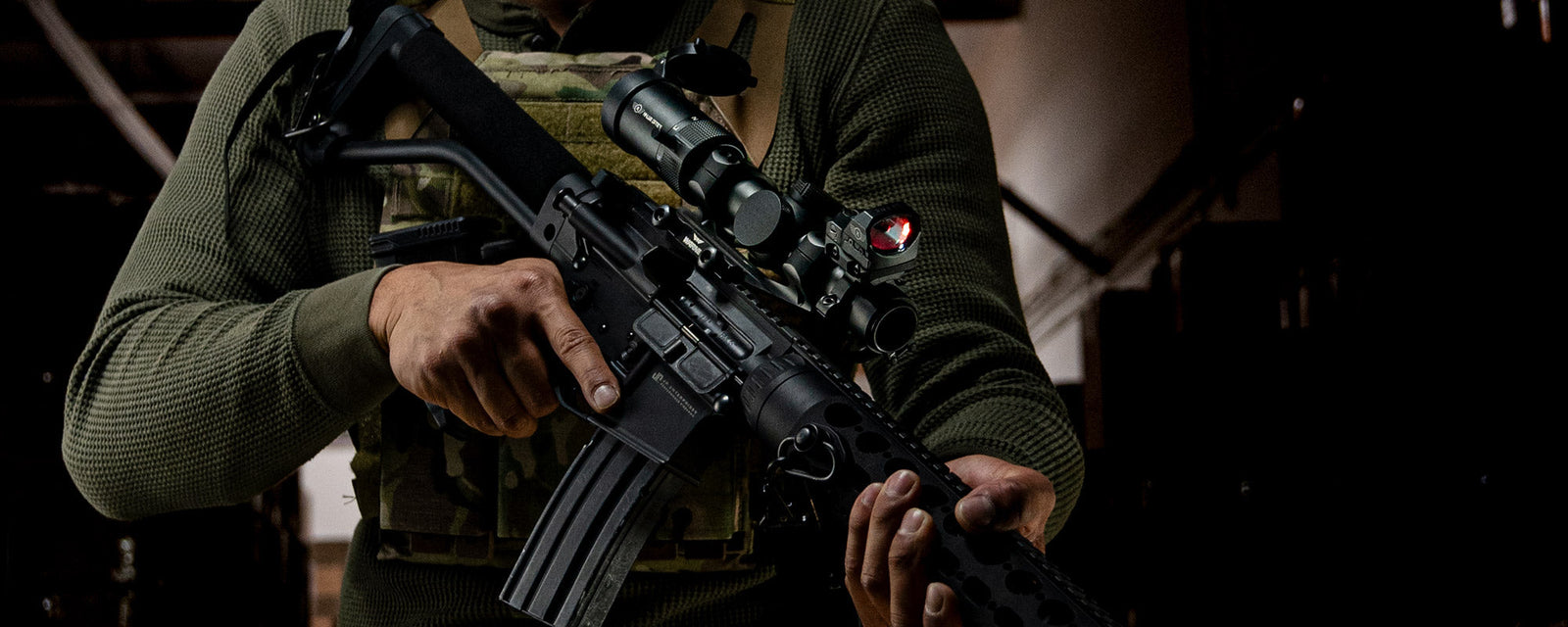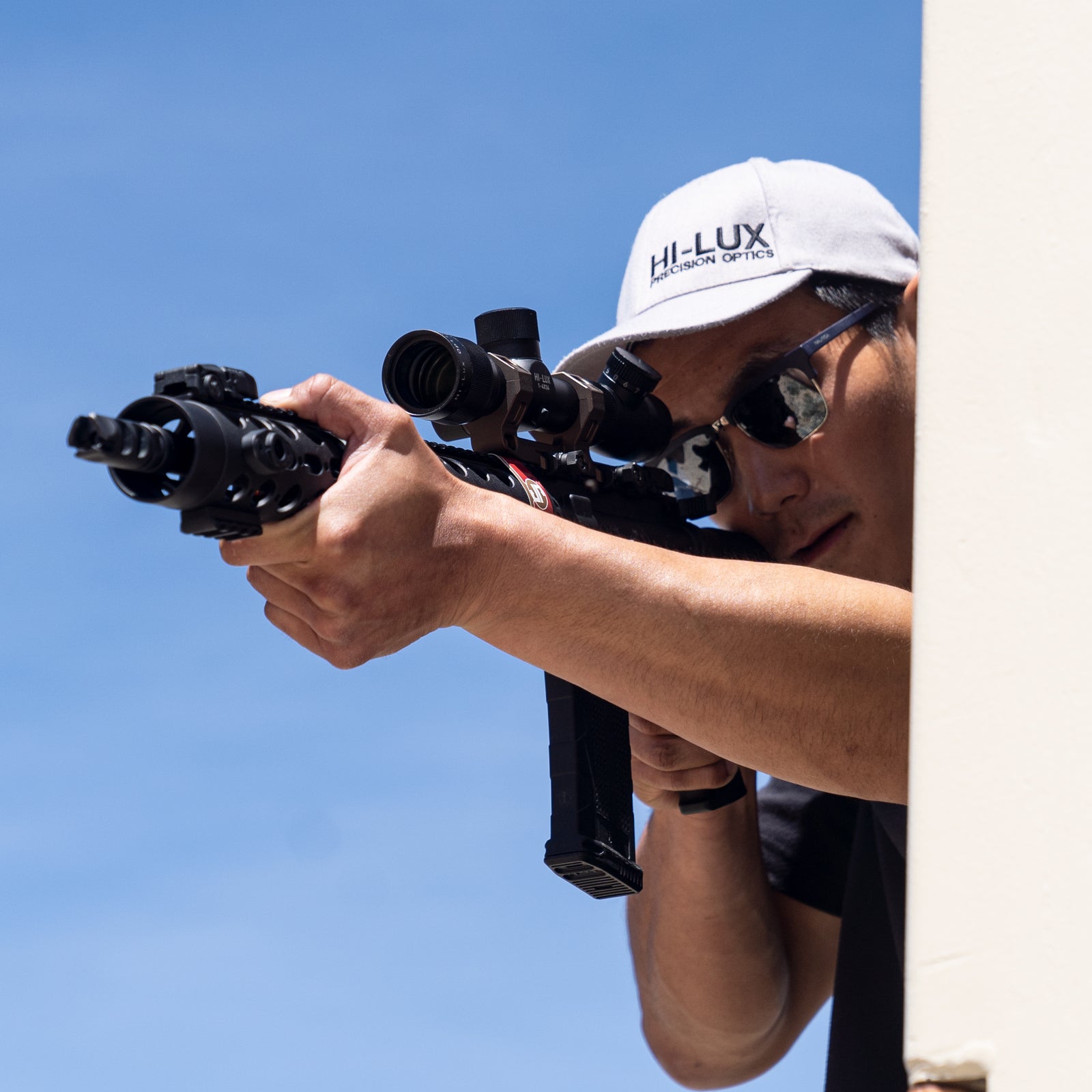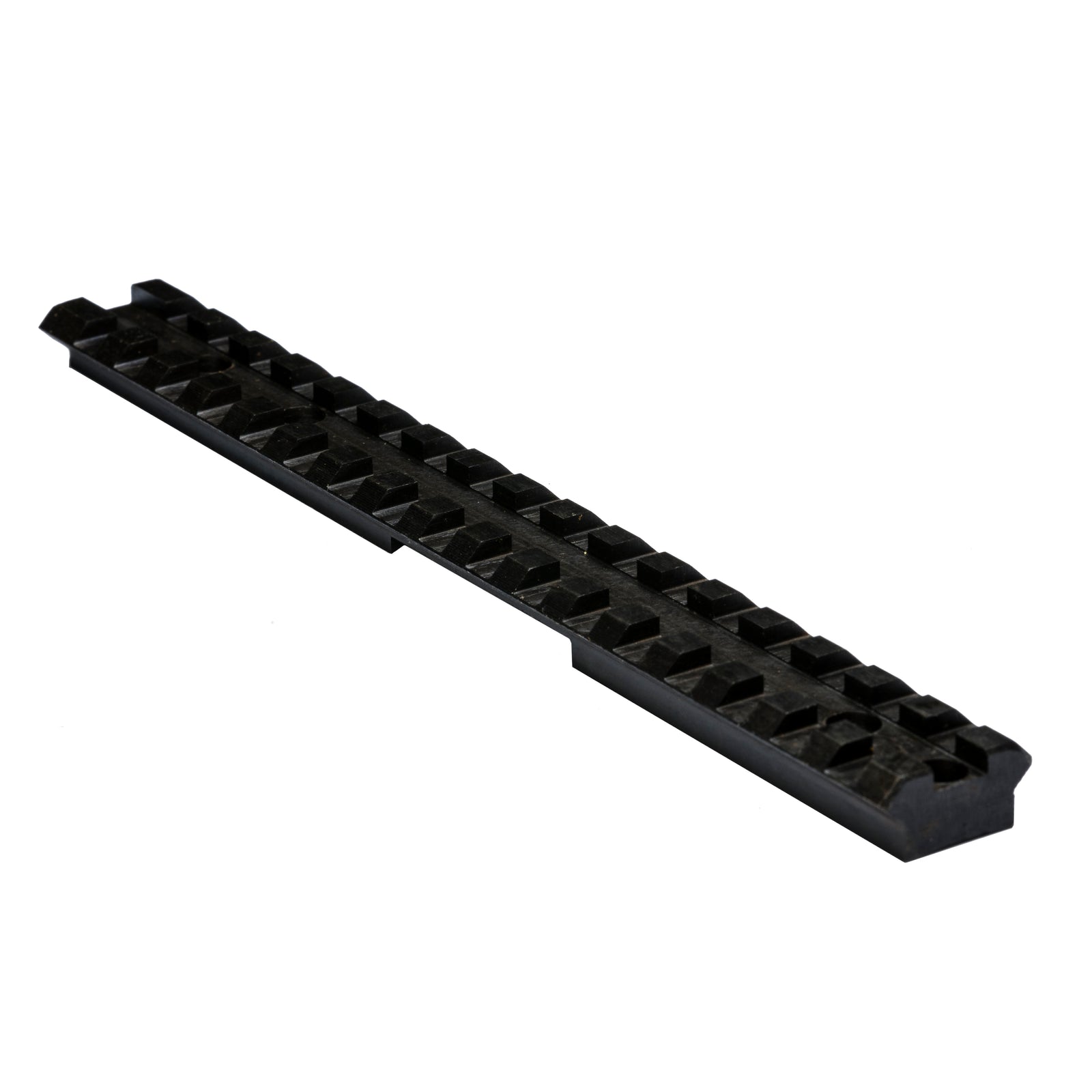For the podcast (audio) version, please check here.
The M40. A revered name with few variations throughout history - the M40, M40A1, M40A3, M40A5. In the fifty years since its inception, the Marines’ update to the Remington 700 system has stood the test of time with its durability, simplicity, and hard-hitting rounds.
The goal, as with most long-range platforms, is a consistent first-round hit. That’s not to say that every shot will be taken at extreme range - but it’s useful to have a rifle capable of delivering that level of accuracy. The American military of the early 1900s looked for existing sniper platforms that could fit the bill. For WWI, the 1903 rifle provided a ready piece of hardware to facilitate different optical systems, stretching afterward into WWII:
- The M1908 & M1913 musket sights
- The M73, a re-stamped Weaver 330C
- The M82, one of two variants of the Lyman Alaskan
- The A5, a well-mounted Winchester 5A (or Lyman A5)
- The Unertl 7.8X, using the A5’s mounting system for a Unertl target scope
At the time of the Vietnam war, the only suitable rifles for such a purpose were old holdovers from World War II and Korea. Commonly, this meant a 1903 with 8X Unertl (Model 1941) or scope-mounted M1C and M1D Garands. The Army went on to develop the M14 further, yielding the XM21.
The Marine Corps decided to take a different approach.
M40 (1966-1976)
The Corps began testing commercially available rifles for accuracy, durability, and availability. The goal was to craft a rifle out of available inventory that would, at its completion, deliver dependable precision in a durable package.
Edward J. Land, Jr. had served in the Marines from 1953-77 and was key in developing the Marines’ sniper program at the time of the M40’s development. In Vietnam, Land would serve as the Officer in Charge of the 1st Marine Division Sniper Teams, training such snipers as Carlos Hathcock. (Hathcock more commonly used a Winchester Model 70 with 8X Unertl scope, and will not be spending much time in this article)
Remington’s Custom Shop in Ilion, N.Y. was eventually chosen for procurement. Land remarked that Remington’s rifles were made more attractive because, “Remington was willing to work with the Corps and provided us with a custom gun ready for immediate service.”
Of Remington’s offerings, the Marines chose the Remington 700-40X Target Model receivers. The receivers were stamped with the necessary markings for their military service, and outfitted with free-floating chomemoly steel barrels. Their actions were left factory-bedded in their smooth wood stocks. The stock would provide one of the first opportunities for later improvement. The stocks featured fixed sling swivels. The rifle’s metal parts included a matte Parkerized finish. The entire package also shipped with a plastic carrying case to fit the rifle, scope, and necessary cleaning supplies.
The initial scope supplied with the M40 platform was one of the major changes from prior sniper doctrine. Many scopes in service had been fixed-power until this point, including the 8X Unertl, roughly 2.5X Lyman and Weaver, and 6X or less Warner & Swasey musket sights. The new variable-power Redfield Accu-Range had magnification from 3-9X. The reticle was also considerably more feature-rich, with a set of ranging lines and a distance scale (‘tombstone’). Unlike the Unertl scope favored by the Marines in WWII, this scope had internal adjustments and did not slide under recoil. The scope mount used to fasten the Redfield to the Remington 700 receiver was also supplied by Redfield, and was quite similar to the mounts supplied for the M1903A4. Most notably, however - the scope was colored green. Even today, this is unusual.
- Caliber - 7.62x51mm NATO
- Capacity - 5 rounds
- Barrel - 24”, 1:10” RH twist, chromemoly
- Stock - American Walnut with oil finish
- Buttplate - Aluminum (Rem.)
- Trigger Guard / Floorplate - Aluminum (Rem.)
- Sights - Redfield 3-9X Accu-Range
- Weight - 9.25 lbs.
The Corps contracted Remington for 700 rifles of the 700-40X design, and initial delivery began in 1966. The problems faced by a wood stock became apparent quickly. In Vietnam’s high-humidity and high-mud environment, the stock swelled. The channel for the free-floating barrel became packed with debris. The only remedy was to scrape and re-seal the stock.
In 1969, of the 82 rifles then allocated to the 1st Marine division, 45 remained in the field. 22 were sidelined with questionable serviceability. By 1973, only 425 available M40 rifles remained across the Corps. Problems extended beyond the wood stock, including barrels that pitted under chemical damage, scopes cracking near the magnification ring, and reticles with broken or melted tombstones.
It was time for an upgrade.
During the M40’s time in service, it saw storied use in the hands of such snipers as Charles “Chuck” Mawhinney. The son of a WWII Marine veteran, Mawhinney joined the Corps in the summer of 1967, and returned home in 1969. During his year and a half in Vietnam, he accumulated 103 confirmed kills and 216 probable kills. He operated under the rule, “if they had a weapon, they were going down.”
M40A1 (1977, 1980 - 2001)
1977 marked a turning point in the life of the M40. Rather than start over with a new rifle, the Marines decided to rebarrel and re-stock the original actions still in service (while new actions were ordered to replace those that were worn out or lost). Atop those two changes, the internal magazine box and recoil lug were welded directly to the receiver to form a singular assembly. The aluminum trigger guard and floor plate was replaced with steel components from the Model 70 rifle. The new barrel was of the same length as the previous version, but was instead an Atkinson stainless tube with a black oxide coating. The stock was replaced with a fiberglass stock from McMillan, finished in green and earth red camouflage. Finally, the rifle would resist most environmental factors. Unfortunately, this came at the cost of nearly 3 additional pounds of weight.
This combination was termed the M40A1.
- Caliber - 7.62x51mm NATO
- Capacity - 5 rounds
- Barrel - 24”, 1:12” RH twist, stainless steel
- Stock - Synthetic (McMillan)
- Buttplate - Brown Rubber (Pachmayr)
- Trigger Guard / Floorplate - Steel (mod. M70)
- Sights - Redfield 3-9X Accu-Range or Unertl 10X Mil-dot
- Weight - 12 or 14.5 lbs.
By 1980, the M40A1 featured another significant change: a new scope. The off-the-shelf option found in the Redfield 3-9X had become a potential point of failure, and a more durable alternative was needed. The potential contract didn’t interest many manufacturers due to its low quantity requirements. In 1980, Unertl, a name already respected among target shooters and students of military history, submitted an answer. Following in their tradition of fixed-power, high magnification optics, the new design was a 10X steel tube.
The Unertl 10X had a number of differences from scopes then in the commercial arena. For one thing, the sturdy steel tube and thick optical components were regarded as strong enough to “drive in a tent-pole.” The reticle included the new “mil-dot” (milliradian dot) system stretching along the horizontal and vertical crosshairs. The new rings were supplied by Unertl, and included lugs that slipped into the receiver to discourage movement under recoil. The turrets featured markings calibrated specifically for the M118 Lake City Match ammo in use by the M40A1.
The rifle had by now run up to 14.5 lbs in total weight. In total, the M40A1 would be 5 ¼ lbs heavier than the original M40 fielded in Vietnam.
The M40A1 saw service for nearly 20 years, across a variety of environments, from Lebanon to Iraq and Somalia. LCpl Anthony Swofford, a scout sniper with the Surveillance and Target Acquisition Platoon of the 2nd Battalion, 7th Marine Regiment, detailed his training and experiences with the A1 in his 2003 book “Jarhead.” The book, along with a 2005 film by the same name, detail his experiences in Operations Desert Shield and Desert Storm.
The M40A2 variant was skipped for (potentially) two reasons. One explanation provides that the M40A2 designation was already in use (for a 106mm recoilless rifle, detailed in FM 23-82 ). Another was that an M40A2 was developed with McMillan and possibly tested, but never made it to production.
M40A3 (2001 - Present)
The Marines began developing the next iteration of the M40 line in 1996, finally concluding in 2001. While previous versions of the M40 remained relatively unchanged over the long term, the M40A3 and later models would see gradual changes over the course of years.
Much like previous M40s, the A3 starts life around the Remington 700 Short Action with a .308 bolt face. These actions are tuned and sized by Marine armorers. There, the armorers also replace the trigger guard and floorplate. Prior to 2007, the trigger guard assembly was manufactured by DD Ross Company. Following this, a change was made to Badger Ordnance’s M5 detachable magazine trigger guard.
The barrel remained stainless steel, but moved from a Hart production to Schneider’s Match Grade model (#635), 25” in length. It features the same 6-groove rifling as previous models, and a 1:12” twist. This barrel is heavier than previous medium-weight barrels on the M40A1.
The stock is still made by McMillan in fiberglass, though the design has changed. It is cast-molded in OD Green, in a benchrest-style configuration known as the A4 Tactical Riflestock. The stock attaches to a bipod (Harris notched swivel-type with KMW podlock) via a stud on the underside of the forend. The action is glass-bedded into the stock, while the barrel remains free-floated. There are also 6 flush-mount sling swivel cups, providing left, right, and center sling points at the front and rear.
- Caliber - 7.62x51mm NATO
- Capacity - 5 rounds
- Barrel - 25”, 1:12” RH twist, stainless steel
- Stock - Synthetic Tactical A4 (McMillan)
- Buttplate - Brown Rubber (Pachmayr)
- Trigger Guard / Floorplate - (DD Ross or Badger Ordnance)
- Sights - Unertl 10X or Schmidt & Bender 3-12X50mm, later Premier Reticles 3-15X50mm
- Weight - 16.5 lbs.
For long range applications, another change needs mentioning: the scope. At the onset of the A3 system, the Unertl MST-100 10X scope remained in place from the M40A1 days. Before too long, this was replaced with a Schmidt & Bender 3-12X50 Police Marksman II LP scope. As of 2010, this scope was in turn replaced by the Premier Reticles Heritage 3-15X50mm Tactical. It is interesting to note that, in the three latest scopes, illumination of the reticle is of secondary or nonexistent concern, and the turrets have a blocky design up to the knurling reminiscent of the Unertl 10X. I’m not sure if the Corps has a particular aesthetic regarding scopes, but I’m suspecting this may be the case.
At any rate, the latest scope is mounted on a DD Ross 30MOA picatinny rail. The front ring’s cap is replaced with a SPA-Defense B6634 34mm Male Dovetail, to facilitate mounting the Simrad KN200 Night Vision sight.
M40A5 and Later (2009 - Present)
In 2009, the M40A5 designation finally superseded the A3. The A5 is fortunately not drastically different from the A3. The A3’s barrel has a target crown, while in the A5 this is replaced with a straight-tapered barrel and threaded muzzle. Mounted onto this threading is a Surefire muzzle brake and sound suppressor. In addition, all A5s are equipped with the Badger Ordnance M5 detachable magazine system. Furthering low-light optics, they also come equipped with a forward rail mount for the AN/PVS-22 night vision optic.
The changes to the A5 system do not drastically change the weight, and this rifle is listed in many locations as having the same Schmidt & Bender 3-12X50 scope. The trigger pull is lighter in this version, around 2.5 lbs. Traditionally, the M40 platform had a pull of between 3-5 lbs.
- Caliber - 7.62x51 NATO (.308 Win)
- Capacity - 5 rounds
- Barrel - 25”, 1:12” RH twist, Schneider contract barrel
- Stock - Synthetic Tactical A4 (McMillan)
- Trigger Guard / Floorplate - Badger Ordnance M5
- Sights - Schmidt & Bender 3-12X50mm
- Weight - 16.5 lbs.
At present, the M40A5 is one of the most precise systems for long range lead delivery. Commonly performing with sub-MOA accuracy, this rifle is truly an example of the capabilities of the sniper. While some rifles may miss due to inexperience and misuse, the training and capabilities of the Corps ensures that this rifle is in good hands.





Joe
August 26, 2024
Regarding the A3 and A5…..
It’s technically true that their barrels are 25", however, that’s the overall length including the tenon. The barrels measure 24" from the recoil lug. They’re not 25" finished length.